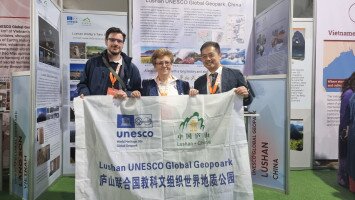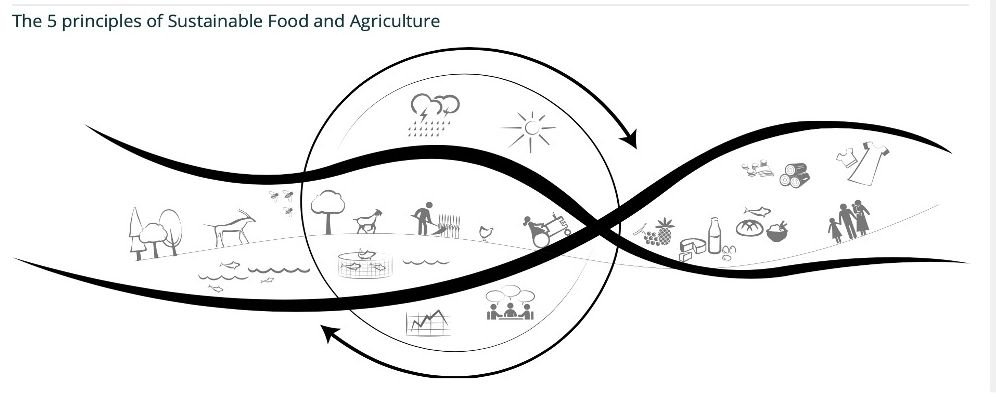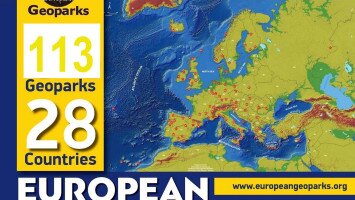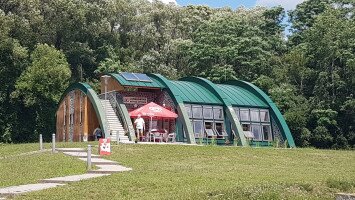
A GEOfood küldetésnyilatkozata
Az élelmiszeripar a társadalom kulcsfontosságú szereplője a fenntartható fejlesztési célok (SDG) 2030-ig való teljesítéséhez szükséges mélyreható változások elérésében. A mezőgazdasági ágazat alapvető szerepet játszik az éghajlatváltozással, a biodiverzitás csökkenésével, az élelmiszerhiánnyal és a népesség növekedésével kapcsolatos világméretű kihívások kezelésében. Földünk 570 millió gazdaságából mintegy 500 milliót, vagyis 88% -ot a családi farmok képviselnek, az élelem 80% -át ők állítják elő.
Klímaválság - aktuális forgatókönyv
Az élelmiszer-termelés és a gyapottermesztés, a bioüzemanyagok, valamint a mezőgazdaságból és az erdőgazdálkodásból származó egyéb nem élelmiszeripari termékek a fejlett és a fejlődő országokban a környezet degradációjának legjelentősebb mozgatórugói. A világ trópusi erdőinek felét kiirtották és továbbra is évente mintegy 18 millió hektárt veszítünk –nagyjából akkora területet, mint pl. Anglia és Wales. A biodiverzitás csökkenése ma a normál sebesség 1000-szerese, és a főbb fajok populációja körülbelül 60 százalékkal csökkent 1970 óta. Az egy főre jutó hús- és tejtermékigény növekedése tovább növeli a termőföld iránti keresletet, miközben a világ népessége a század végére a becslések szerint7,6-ról 11 milliárdra nő. Ez azt jelenti, hogy kevés lehetőség van a mezőgazdaság további bővítésére anélkül, hogy az aláásná a kritikus környezeti és éghajlati célkitűzéseket.
Az intenzív gazdálkodás, beleértve az egyre növekvő vegyi anyagokra való támaszkodást az okai, hogy a rovarok mintegy 80%-a eltűnt Németországban az 1980-as évek óta, de hasonló trendeket jelentettek meg a világ más tájairól is.
A mezőgazdaság, az élelmiszer-feldolgozás és az ebből eredő földhasználat-változás felelős az üvegházhatású gázok globális kibocsátásának csaknem egyharmadáért. Az emberek fenntarthatatlan mennyiségű vad(nem tenyésztett) halat is kifognak, a kereskedelmi halászatok harmada pedig túlhalászottnak minősül. Alig több mint fél évszázad alatt az emberek kiirtották a főbb ragadozó halak, például a tonhal, a kardhal és a cápák populációinak 90 százalékát. Ezenkívül az olyan romboló halászati technikák, mint a vonó fenékháló, hatalmas károkat okoznak a part menti és tengeri ökoszisztémákban. Az előrejelzések szerint a világ népességének fele 2030-ig megtapasztalja a vízhiányt, miközben a vízfelhasználás kétharmada a mezőgazdaságban jelentkezik. Mivel az öntözés különösen gyakori a vízhiányos régiókban, az ágazat felelős a vízfogyasztás 90-95 százalékáért. Végül az élelmiszer-rendszer felelős a nitrogén-kibocsátás legalább háromnegyedéért, amely az algavirágzást és az elhalt zónákat okozza az édesvízi ökoszisztémákban és az óceánban. Becslések szerint a reaktív nitrogénfajok kibocsátása már a kétszerese a fenntartható maximális szintnek, és hasonlóak az aggályok a foszforral kapcsolatban is. Az óceánokban a megnövekedett tápanyag-koncentráció más vízszennyezéssel és az éghajlatváltozás miatti emelkedő hőmérséklettel együtt súlyos terhet ró a tengeri ökoszisztémákra. A 2016-2017 évi nagy hőhullám a Nagy Korallzátony mintegy 90 százalékát érintette és a korallok fele elpusztult.
Az EU hosszú távú stratégiát dolgozott ki az üvegházhatást okozó gázok zéró nettó kibocsátásának 2050-ig történő elérése érdekében („Green Deal” Európai Bizottság, 2020). A megfelelő élelmiszer-, takarmány- és rosttermelés továbbra is kulcsfontosságú marad az európai gazdaság számára, ugyanakkor várhatóan a mezőgazdaság és az erdőgazdálkodás is hozzájárul a század közepéig a szén-dioxid-semlegességi célkitűzéséhez. A megfelelő élelmiszer, takarmány és rost előállítása továbbra is központi szerepet játszik az európai gazdaságban. Ugyanakkor a mezőgazdasági és az erdészeti ágazat várhatóan hozzájárul a század közepének széndioxid-semleges célkitűzéséhez. A biomassza iránti kereslet várhatóan meg fog nőni a hő, a bioüzemanyagok, a biogáz, az építőanyagok és a fenntartható bioalapú termékek, például a biokémiai termékek előállítására. A megnövekedett biomassza-ellátás várhatóan különböző forrásokból fog származni a termelés fenntarthatóságának biztosítása és a meglévő erdők szénelnyelő-képességének stabilizálása vagy fokozása érdekében. A mezőgazdaságból származó nem CO2-kibocsátás csökkentése elsősorban innováció révén fog megvalósulni, pl.: precíziós gazdálkodás a műtrágya és egyéb vegyi anyagok terepi felhasználásának optimalizálása érdekében, a szarvasmarha termelékenység javítása és a trágya kezelése aerob emésztőkben. Az EU stratégiája a mezőgazdasági földterületek szén-dioxid-megkötésének fokozására is épül a jobb gazdálkodási gyakorlatok révén, ideértve az agrárerdészeti technikákat, a zéró-szántást és a takaró-vetemény,-növények használatát.
Végül a leromlott ökoszisztémák erdősítése és helyreállítása számos célkitűzéshez hozzájárulhat: CO2-megkötés, biológiai sokféleség, talaj- és vízmegőrzés, valamint biomassza-termelés.[1]
A fenntartható élelmiszer- és mezőgazdaság 5 alapelve

1) Az erőforrások felhasználási hatékonyságának javítása.
2) Közvetlen fellépés a természeti erőforrások biztosítása és védelme érdekében.
3) A mezőgazdaság javítsa a vidéki megélhetést, a méltányosságot és a társadalmi jólétet.
4) Fokozza az emberek, a közösség és az ökoszisztéma ellenálló képességét.
5) Felelősségteljes és hatékony irányítási mechanizmusra van szükség.
Hogyan érhetjük el ezt az 5 fő pontot?
A jólét felé vezető utat egyértelműen jelöli a 2030-ig szóló fenntartható fejlődés menetrendje. Átalakító cselekvésre van szükség, a fenntarthatóság elveinek érvényesítésével, valamint a szegénység és az éhezés kiváltó okainak kezelésével, hogy senkit se hagyjanak hátra.
A fenntartható táplálkozásnak átfogó stratégia részét kell képeznie az élelmiszerek, az élelmezésbiztonság javítása, az élelmiszer-termelők megélhetésének javítása, a gazdasági fejlődés támogatása, az éghajlatra gyakorolt hatás csökkentése és az ökoszisztéma helyreállítása érdekében.
Ez a 20, egymáshoz kapcsolódó cselekvés felöleli a 2030-ig tartó menetrend fenntartható fejlődésre vonatkozó elképzelését, amelyben az élelmiszer- és a mezőgazdasággal, az emberek megélhetésével és a természeti erőforrások kezelésével nem külön-külön foglalkoznak, hanem egységként kezelik. Annak érdekében, hogy a jövőben a hangsúly ne csak a végcélra, hanem azok elérésének eszközeire is összpontosuljon szükséges egy olyan környezet, amelyben az állami és a magánszereplők részt vesznek a fejlesztési megoldások legitimálásában, tervezésében és fejlesztésében.
Ezek az intézkedések integrálják a fenntartható fejlődés három dimenzióját, ahol a részvételre és partnerségre van szükségük a különböző szereplők között. Ezek az intézkedések integrálják a fenntartható fejlődés három dimenzióját és részvételt és partnerséget igényelnek a különböző szereplők között. A szinergiák beazonosítása, a kompromisszumok megértése és az ösztönzők felvázolása révén ez a 20 akció azokat a valódi kérdéseket kezeli, amelyekkel az országok az éhezés nélküli (Zero Hunger) világ és a mindenki számára szebb jövő felépítése során szembesülnek.
1. Elérés megkönnyítése a termelési erőforrásokhoz, pénzügyekhez és szolgáltatásokhoz.
2. A kisgazdálkodók és a piac összekapcsolása.
3. A termelés és a jövedelem diverzifikálásának ösztönzése.
4. A termelők ismereteinek bővítése és képességeik fejlesztése.
5. A talaj egészségének javítása, helyreállítása.
6. A vizek védelme és a vízhiány kezelése.
7. A biodiverzitás megőrzése és az ökoszisztéma funkcióinak védelme.
8. A veszteségek csökkentése, az újrafelhasználás, az újrafeldolgozás és a fenntartható fogyasztás elősegítése.
9. Az emberek megerősítése és küzdelem az egyenlőtlenségekkel szemben.
10. A földtulajdon biztonságának előmozdítása.
11. Szociális védelmi eszközök kidolgozása a termelékenység és a jövedelem növelésére.
12. A táplálkozás javítása és a kiegyensúlyozott étrend elősegítése
13. A sokkok megelőzése és védelme: az ellenállóképesség növelése
14. Felkészülés és válaszok a sokkokra
15. Az éghajlatváltozás kezelése és az ahhoz való alkalmazkodás.
16. Az ökoszisztéma ellenálló képességének megerősítése
17. A politikai párbeszéd és koordináció fokozása.
18. Az innovációs rendszerek megerősítése.
19. A beruházások és a pénzügyek alakítása, javítása.
20. Meg kell erősíteni az ösztönző környezetet és meg kell reformálni az intézményi keretet.
Az UNESCO Globális Geoparkok szerepe a Fenntartható Élelmiszer- és Mezőgazdaság területén
Az UNESCO globális geoparkok definíciója: „egyedi, összefüggő földrajzi területek, ahol a nemzetközi geológiai jelentőségű helyeket és tájakat a védelem, az oktatás és a fenntartható fejlődés holisztikus koncepciójával kezelik”. Egyre népszerűbb az alulról építkező megközelítésük, amely a természetvédelem és a fenntartható fejlődés ötvözését jelenti a helyi közösségek bevonásával.
A geoparkok számos különféle tevékenységet folytatnak a kultúra, az idegenforgalom, az oktatás és a fenntartható fejlődés, valamint a helyi élelmezés terén. Bár a geoparkok nagyon egyedi területek eltérő a területmérettel, helyi gazdasággal, társadalmi háttérrel, kultúrával és tájjal, a legjellemzőbb geoparki tevékenységek körében az élelmiszerrel való kapcsolat nagyon gyakori az egész világon. Valójában a helyi élelmiszerek fenntarthatósága, a mezőgazdasági tevékenységek és a helyi termelők valorizálása, a természeti erőforrások és az idegenforgalom közötti kapcsolat az UNESCO globális geoparkok közös témája.
Az UNESCO globális geoparkok az Agenda 2030 részesei és mélyen elkötelezettek a fenntartható fejlődési célok (Sustainable Development Goal - SDG) mellett, amelyek célja a bolygó és természetes környezetének védelme.
A Geoparkok lényege az SGD 12-vel egyetértésben „olyan eszközök kifejlesztése és végrehajtása, amelyek figyelemmel kísérik a fenntartható turizmus fenntartható fejlődésre gyakorolt hatásait a munkahelyteremtés, a helyi kultúra és termékek előmozdítása szempontjából. Az UNESCO globális geoparkok a bevált gyakorlatok és az innovatív megoldások inkubátoraként működnek a helyi közösségekkel egyetértésben, ösztönzik a beruházásokat a mezőgazdasági gyakorlatok fejlesztése, az élelmiszer-rendszerek értékelése, a KKV-k támogatása, a foglalkoztatási lehetőségek növelése és a jobb munkakörülmények érdekében. A geoparkok szoros nemzetközi, nemzeti, regionális és helyi együttműködésben működnek, előmozdítva a partnerségeket és a hálózatépítést.
A GEOfood program kifejezetten hozzájárulhat a következő feladatok kezeléséhez (FAO):
- A vidéki szegénység felszámolása, kritikus lépés az élelmezésbiztonság biztosítása érdekében (SGD 1)
- Az ételnek biztonságosnak, elegendőnek és mindenki számára megfizethetőnek kell lennie (SGD 2)
- A jó egészség a táplálkozással kezdődik (SGD 3)
- A tápláló táplálék kritikus fontosságú a tanulás szempontjából (SGD 4)
- A nemek közötti egyenlőség ötödével növelheti a mezőgazdasági termelékenységet (SGD 5)
- A fenntartható mezőgazdaság képes kezelni a vízhiányt (SGD 6)
- Az élelmiszeripari rendszereknek le kell küzdeniük a fosszilis tüzelőanyagoktól való függőségüket (SGD 7)
- Az élelmiszertermelés növekedése az alacsony jövedelmű gazdaságokban felére csökkentheti a szegénységet (8. SGD)
- Az innováció új piacokat nyit meg a kisgazdák számára (SGD 9)
- A földreform lehetővé teszi a vidéki területekhez való méltányos hozzáférést(SGD 10)
- A vidéki beruházások lassíthatják a kezelhetetlen urbanizációt (SGD 11)
- Az élelmezésbiztonság elérése magában foglalja a hulladék csökkentését (SGD 12)
- A mezőgazdaság kulcsfontosságú az éghajlatváltozásra adott válaszban (SGD 13)
- A hal 3 milliárd embernek adja a napi állati fehérje 20% -át (SGD 14)
- - Az erdők a világ szárazföldi biológiai sokféleségének több mint 80% -át adják (SGD 15).
- Az éhség megszüntetése hozzájárulhat a békéhez és a stabilitáshoz (SGD 16).
- A partnerségek segítenek felhívni a figyelmet a problémákra (SGD 17).
A GEOfood VÍZIÓ, JÖVŐKÉPE
A GEOfood címke mögött világos filozófia rejlik: a márka lényege a helyi közösségek támogatása, a holisztikus és az alulról építkező megközelítés, amely az UNESCO globális geoparkjait jellemzi.
A GEOfood az UNESCO globális geoparkokon belüli márka és csak az ilyen UNESCO dezignációjú területeken használható.
A GEOfood célja, hogy 2023 végéig az európai UNESCO globális geoparkok legalább 30% -ában, 2025-ig pedig a világ többi részén található geoparkok 10% -ában használatban legyen.
GEOfood MISSZIÓ
A GEOfood küldetése a helyi közösségek fenntartható fejlődésének támogatása és az ENSZ nemzetközi fenntarthatósági célkitűzései (SDG-k) elérése érdekében tett intézkedések fokozása.
A GEOfood célja, hogy az UNESCO globális geoparkok értékrendje és az alulról felfelé építkező megközelítés keretében működjön.
GEOfood CÉLOK
A GEOfood célja a helyi szereplők és a Geopark identitása közötti kapcsolat megerősítése.
A fő cél elsősorban a nyers élelmiszer és a helyi földtani örökség közötti kapcsolat tudatosítása a közvéleményben: a GEOfood koncepció egy fejlődő címke és egy konkrét magyarázat tagjainak arra, hogy kihangsúlyozzák geológiai örökségük meghatározó kapcsolatát a helyi ételekkel és kulturális hagyományokkal .
A GEOfood egy innovatív módszer a lakosság minden célcsoportjának összekapcsolására a területtel. Az étel egy nemzetközi nyelv, amelyet bárki megérthet; valójában az étel révén az embereket szeretnénk összekapcsolni a talajjal és a természettel, valamint fokozni a tudatos élelmiszerfogyasztást a nulla km-es élelmiszerfelhasználás és az erőforrások felelősségteljes felhasználása érdekében.
A GEOfood márka célja, hogy partneri hálózatot hozzon létre az UNESCO globális geoparkokon belül azzal a közös küldetéssel, hogy befolyásolja a helyi, regionális és nemzeti politikákat, irányelveket az innovatív élelmiszer-rendszer és a területi tervezés irányába, amely megerősítheti a város-vidék kapcsolatokat.
Úgy gondoljuk, hogy az UNESCO Globális Geoparkok kulcsfontosságú szerepet játszanak a vidéki és városi terek összekapcsolásában, a lakossággal és a közösségekkel együtt munkálkodva: a GEOfood támogatni fogja a területeket a kapcsolat megerősítésében, biztosítva számukra a helyi gazdaság erősítésének eszközét.
GEOfood INTÉZKEDÉSEK
✔️ Közösen támogatjuk a fenntartható fejlődést: a GEOfood márkát csak olyan vállalatok használhatják, amelyek megfelelnek bizonyos környezeti normáknak, követelményeknek:
-A biológiai sokféleség előmozdítása és a talaj minőségének javítása felelős, fenntartható farmgazdálkodási gyakorlatok elfogadásával.
-Egészséges környezet és egészséges táplálék létrehozása, különös tekintettel a kémiai és gyógyszerészeti szempontból nem invazív kártevők és gyomok integrált kezelésére.
- A vízkészletek felelős felhasználása
- Hatékony hulladék-újrafeldolgozó rendszer
- Szezonális termékek termesztése
- A munkavállalók jogainak tiszteletben tartása a teljes gyártási folyamat során.
✔️ Együtt dolgozunk a Geopark termelőinek, gazdálkodóinak, vállalkozóinak támogatásán a hagyományok megőrzése és helyi gazdaságuk növelése érdekében.
- GEOfood tanúsítvánnyal rendelkező kis- és középvállalkozások
- A Geopark támogatja a helyi vállalkozásokat: promóciós lehetőségeket kínál számukra, szolgáltatásaikat igénybe veszi (vendéglátás vagy helyszín) a geoparki rendezvényeken vagy konferenciákon.
✔️ Közösen támogatjuk a helyi ételek használatát:
- A GEOfood termékek helyi alapanyagokból származnak.
- Célunk, hogy fokozzuk a napi nulla km-es élelmiszerek használatát mind a magán-, mind az állami szektorban.
- A nulla kilométeres beszállítású élelmiszerek GEOfoodként való népszerűsítése az éttermekben és szállodákban, az egyes Geopark-házakban és az olyan közszolgáltatásokban, mint a menza, az iskolák vagy az irodák.
✔️ Együtt keressük az új projektek lehetőségét, hogy támogassuk a közösségeket az Európai Geopark Hálózaton és a Globális Geopark Hálózaton belül, új oktatási projekteket dolgozunk ki, amelyek középpontjában a helyi gazdaság élelmiszer-pazarlása, a körforgásos gazdaság, a nulla kilométeres élelmiszer, a mezőgazdaság, a fenntartható fejlődés és az idegenforgalom áll.
GEOFood partner geoparkok a nagyvilágban
[1]Sustainable Land-Use and Food System, 2019 Report of the FABLE Consortium.
[2]FAO, http://www.fao.org/sustainability/en/?platform=hoo...













